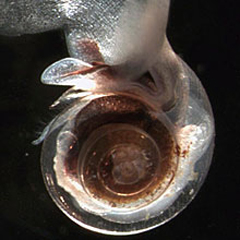Posted on EPOCA: 30 Sep 2011

Too much acid in the ocean is bad news for sea life. Acid eats away at calcium carbonite, the primary ingredient of shells and skeletons that many ocean animals depend on for survival. The shell pictured here is a victim of this process. The normally-prot
IOOS monitoring of our acidifying oceans is helping both the economy and environmental understanding. In terms of the economy, ocean observation sees a multiplied return on investment among many industries. The shellfish industry provides one illustration. IOOS efforts helped bring oyster hatcheries back from the brink of disaster within just a few years. With a $500,000 federal investment in coastal seawater monitoring, some businesses are again major contributors to the $111 million West Coast shellfish industry.
To understand how, it’s important to understand that the ocean absorbs about 26 percent (about 22 million tons) of human-generated greenhouse gas from the atmosphere each day. This excess carbon dioxide (CO2) mixes with seawater to form carbonic acid, which depletes our seas of a nutrient vital to building shells. Known as ocean acidification, this process slows growth or even dissolves shells to the point where oyster larvae cannot survive. Ocean acidification is an emerging global problem, particularly because shelled organisms like oysters are an essential nutrient throughout the entire marine food chain. As human food and a source of income, shellfish also sustain many millions of people worldwide.
In the Pacific Northwest, monitoring efforts detected ocean acidification, providing an understanding of the problem and offering an approach to address it. Information from NOAA’s Ocean Acidification Program and real-time data from offshore IOOS buoys act as an early warning system for shellfish hatcheries. These data signal the approach of cold, acidified seawater one to two days before it arrives in the sensitive coastal waters where larvae are cultivated. The data enable hatchery managers to schedule production when water quality is good.
Armed with better information about ocean conditions that oysters can and cannot tolerate, Taylor Shellfish Farms in Washington State was able to adapt its operations, resulting in the company’s best year since 1989. Whiskey Creek Shellfish Hatchery in Oregon, a major supplier to the majority of West Coast oyster farmers, also enjoyed substantial increases in its oyster harvest. In 2008, productivity for Whiskey Creek was at just 20 percent of its normal level; by 2010, it had risen to 70 percent.
Observing the changes in our marine environments is also critical for adapting to and mitigating negative effects of those changes throughout the planet. The chemistry of the ocean is changing at least 30 times faster in the 800,000 years prior to the industrial era. Keeping an eye on changing ocean conditions through buoy networks and other sophisticated observing systems is paramount. A better grasp on the changes in our planet will help decision makers take appropriate action.
Integrated Ocean Observing System, 22 September 2011. Article.